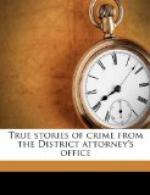“Londonderry, Marquess of, married Oct. 2nd, 1875, Lady Theresa Susey Helen, Lady of Grace of St. John of Jerusalem, eldest daughter of the 19th Earl of Shrewsbury.” Dear me! “Dudley, Earl of, married September 14, 1891, Rachael, Lady of Grace of the Order of St. John of Jerusalem, youngest daughter of Charles Henry Gurney.” I closed the book and began to think, and the more I thought the more I wondered. There really didn’t seem particular need of going further. If the fellow was a fraud, he was a fraud, that was all. But how in Heaven’s name could a man make up a story like that! That night I dreamed once more of the ducal palace of Nivernais, only its courtyard resembled that of the Tombs and many couples walked in a straggling line beneath its walls.
A day or two passed and I had heard no more of the Duc Charles Julius when one afternoon a lady called at my office and sent in her name as Mrs. de Nevers. She proved to be an attractive young woman a little over twenty, dressed in black, whose face showed that she had suffered more than a little. She explained that her husband was confined in the Tombs on a charge of perjury. But that was not all—he was worse than a perjurer. He was an impostor—a bigamist. He had another wife living somewhere in England—in Manchester, she thought. Oh, it was too terrible. He had told her that he was the Count Charles de Nevers, eldest son of the Duc de Nevers—in France, you know. And she had believed him. He had had letters to everybody in Montreal, her home, and plenty of money and beautiful clothes. He had dazzled her completely. The wedding had been quite an affair and presents had come from the Duke and Duchess of Nevers, from the Marchioness of Londonderry and from the Countess of Dudley. There were also letters from the Prince and Princess of Aremberg (in Belgium) and the Counts Andre and Fernand of Nevers. It had all been so wonderful and romantic! Then they had gone on their wedding journey and had been ecstatically happy. In Chicago, they had been received with open arms. That was before the death of the Duke—yes, her mourning was for the Duke. She smiled sadly. I think she still more than half believed that she




